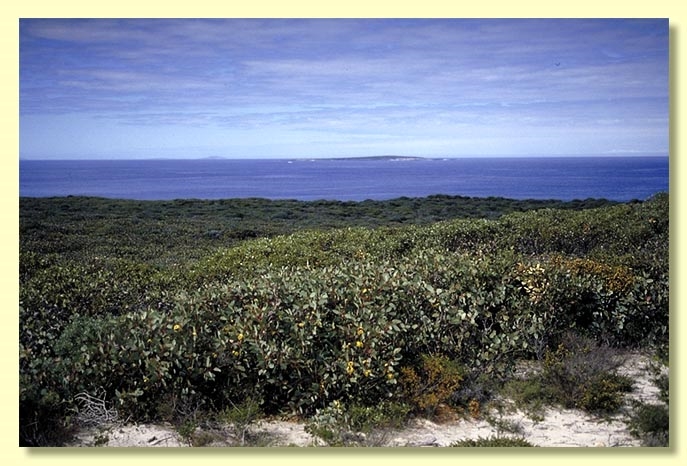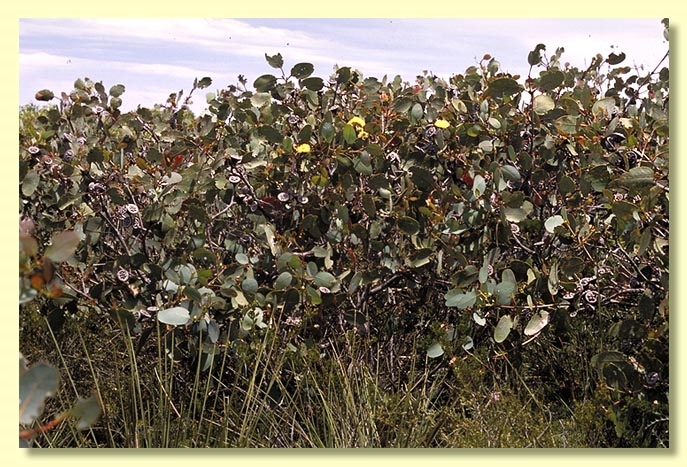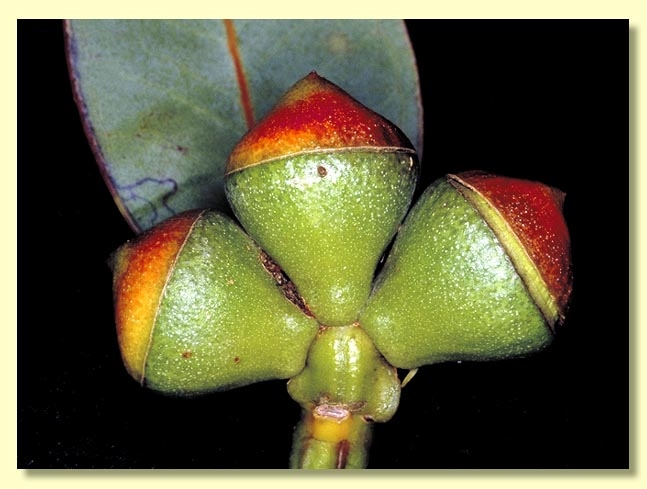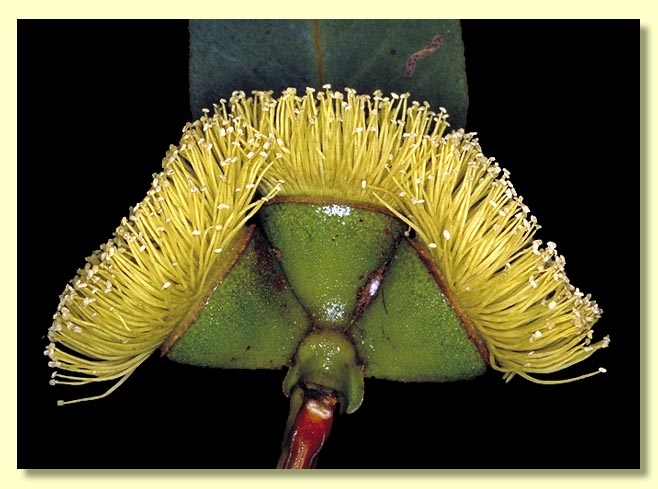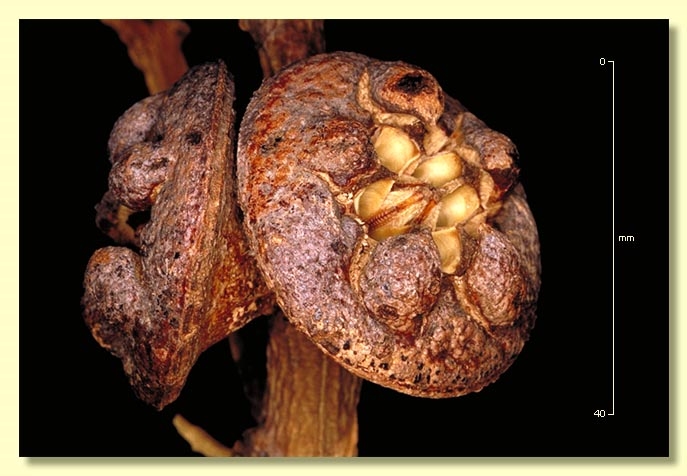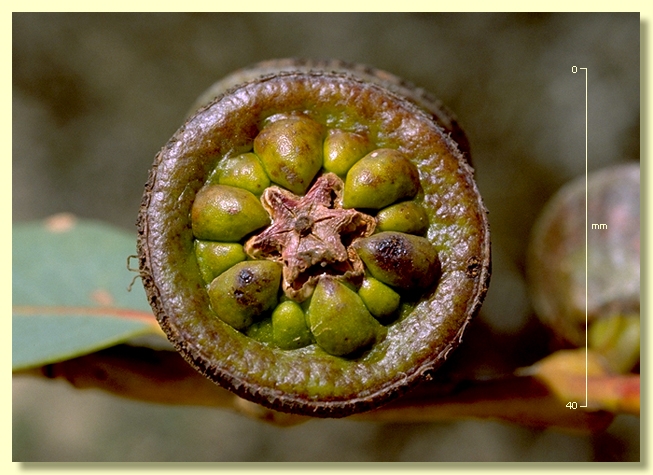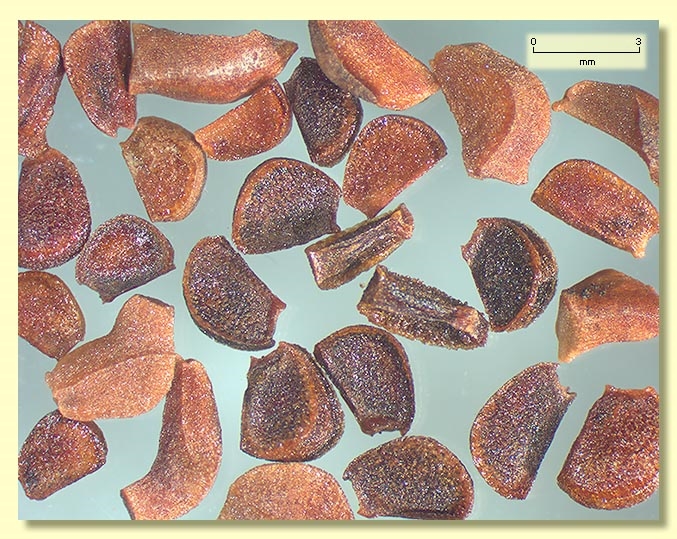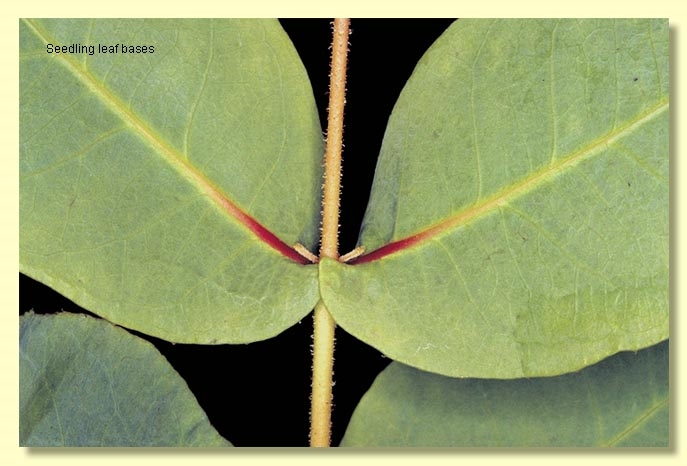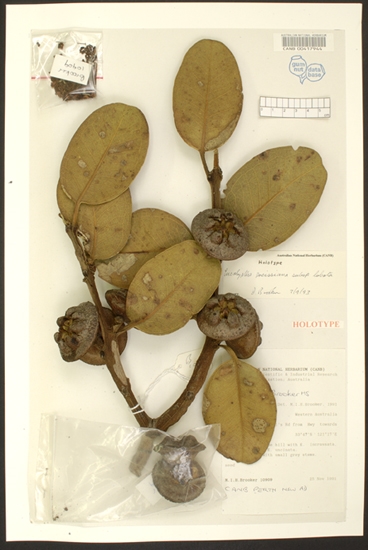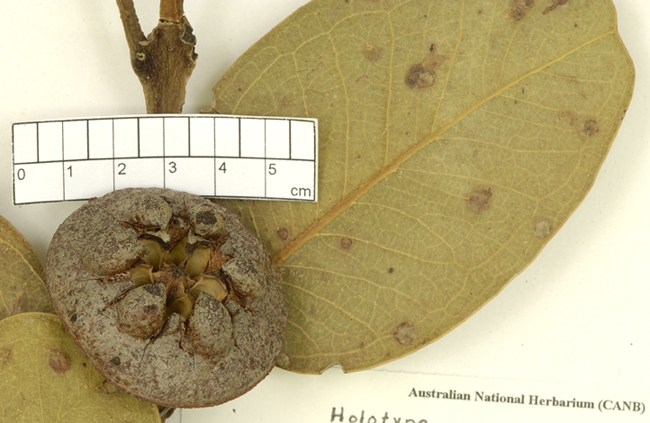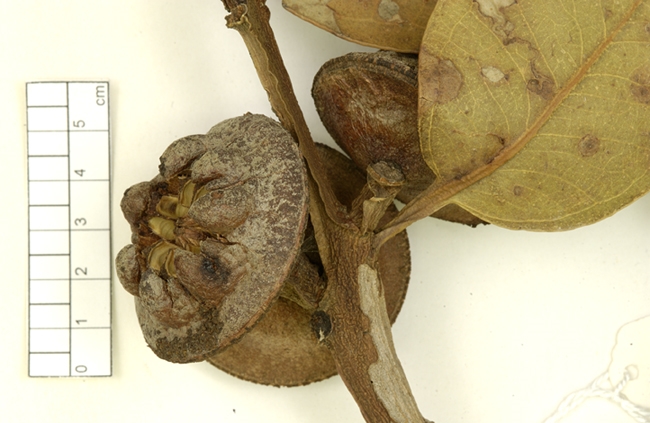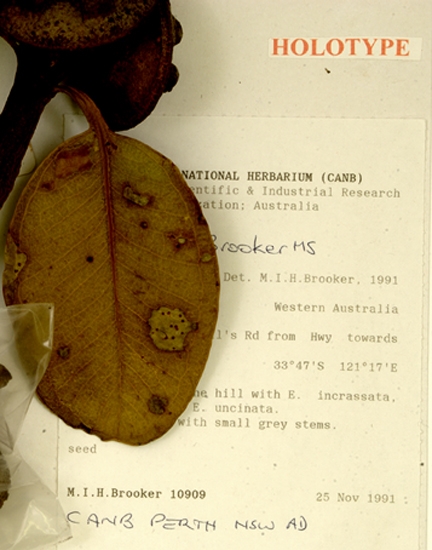Euclid - Online edition
Eucalyptus preissiana subsp. lobata
Classification
Eucalyptus | Eucalyptus | Longistylus | Frutices | Preissianae | Pluriloculares
Nomenclature
Description
Shrub 1 m tall, spreading widely.
Bark smooth, pale grey and brown.
Branchlets lacking oil glands in the pith.
Juvenile growth (coppice or field seedlings to 50 cm): stems square in cross-section; juvenile leaves always petiolate, opposite, elliptical to ovate or oblong, 6–12.5 cm long, 3.5–7.3 cm wide, base rounded, truncate or tapering, apex usually rounded, grey-green to faintly glaucous, glabrous.
Adult leaves thick, opposite or alternate, petioles 1–3 cm long; blade elliptical to ovate or oblong, 6.2–13.5 cm long, 3–7.3 cm wide, base tapering to petiole or rounded, margin entire, apex usually rounded, sometimes notched, concolorous, dull, grey-green, side-veins greater than 45° to midrib, reticulation sparse to moderate, intramarginal vein remote from margin, oil glands irregular, island.
Inflorescence axillary unbranched, peduncles broadly flattened, 0.5–1.7 cm long, buds 3 per umbel, sessile or on pedicels to 0.8 cm long. Mature buds ovoid, 1.5–1.8 cm long, 1.3–1.5 cm wide, scar absent, the single operculum bluntly conical to rounded, stamens inflexed, anthers oblong, versatile, dorsifixed, dehiscing by longitudinal non-confluent slits, style long and conspicuously bent, stigma rounded to tapered, locules 5 or 6(7), the placentae each with 2 vertical rows of ovules. Flowers yellow.
Fruit sessile or on pedicels to 0.5 cm long, very shallowly and broadly obconical, 1.1–2 cm long, 3.5–5.3 cm wide, disc lobed over the 5 to 6(7) valves which are partly lost.
Seeds dark brown, 3–4 mm long, cuboid to D-shaped (seed and chaff very similar), dorsal surface minutely granular, hilum terminal.
Cultivated seedlings (measured at ca node 10): cotyledons reniform; stems rounded in cross-section, scabrid-hairy; leaves sessile, opposite, amplexicaul for at least 10 nodes, ovate to broadly elliptical, 5.5–10 cm long. 4–5.5 cm wide, green to greyish green, glabrous above but distantly hairy/denticulate on margins and hairy on mid-rib underneath.
Bark smooth, pale grey and brown.
Branchlets lacking oil glands in the pith.
Juvenile growth (coppice or field seedlings to 50 cm): stems square in cross-section; juvenile leaves always petiolate, opposite, elliptical to ovate or oblong, 6–12.5 cm long, 3.5–7.3 cm wide, base rounded, truncate or tapering, apex usually rounded, grey-green to faintly glaucous, glabrous.
Adult leaves thick, opposite or alternate, petioles 1–3 cm long; blade elliptical to ovate or oblong, 6.2–13.5 cm long, 3–7.3 cm wide, base tapering to petiole or rounded, margin entire, apex usually rounded, sometimes notched, concolorous, dull, grey-green, side-veins greater than 45° to midrib, reticulation sparse to moderate, intramarginal vein remote from margin, oil glands irregular, island.
Inflorescence axillary unbranched, peduncles broadly flattened, 0.5–1.7 cm long, buds 3 per umbel, sessile or on pedicels to 0.8 cm long. Mature buds ovoid, 1.5–1.8 cm long, 1.3–1.5 cm wide, scar absent, the single operculum bluntly conical to rounded, stamens inflexed, anthers oblong, versatile, dorsifixed, dehiscing by longitudinal non-confluent slits, style long and conspicuously bent, stigma rounded to tapered, locules 5 or 6(7), the placentae each with 2 vertical rows of ovules. Flowers yellow.
Fruit sessile or on pedicels to 0.5 cm long, very shallowly and broadly obconical, 1.1–2 cm long, 3.5–5.3 cm wide, disc lobed over the 5 to 6(7) valves which are partly lost.
Seeds dark brown, 3–4 mm long, cuboid to D-shaped (seed and chaff very similar), dorsal surface minutely granular, hilum terminal.
Cultivated seedlings (measured at ca node 10): cotyledons reniform; stems rounded in cross-section, scabrid-hairy; leaves sessile, opposite, amplexicaul for at least 10 nodes, ovate to broadly elliptical, 5.5–10 cm long. 4–5.5 cm wide, green to greyish green, glabrous above but distantly hairy/denticulate on margins and hairy on mid-rib underneath.
Flowering Time
Flowering has been recorded in October.
Notes
Eucalyptus preissiana is a low sprawling mallee species endemic to Western Australia. It occurs in coastal and subcoastal areas from the Stirling Range and Fitzgerald National Park east almost to Esperance. The stems are smooth and the adult leaves thick, dull, light green.
Eucalyptus preissiana belongs in Eucalyptus subgenus Eucalyptus series Preissianae, a small group characterised by smooth bark, buds in threes, buds with a single operculum (hence no operculum scar), cuboid anthers that shed pollen by two separate slits, ovules arranged in two rows on the placenta, fruit that are large with the disc lobed over the valves and seed pyramidal to cuboid and seedlings with sessile, opposite leaves for at least 10 nodes.
There are 4 species in series Preissianae viz. E. megacarpa, E. preissiana, E. coronata and E. aquilina. The most divergent species of this subgroup is E. preissiana which has brown seeds, smooth buds and yellow flowers but one form of it (E. preissiana subsp. lobata) has broadly obconical fruit very similar to those of the white-flowered tall slender mallee E. aquilina. E. coronata has strongly ribbed buds and fruit, whilst E. megacarpa has smooth buds, cupular to bell-shaped fruit and is usually a tree.
There are two subspecies:
E. preissiana subsp. preissiana
Comparatively small cupular to obconical fruit (2–3.5 cm wide) with the disc descending slightly but with conspicuously raised lobes covering the valves.
E. preissiana subsp. lobata
Strictly coastal and of low dense shrub form, found scattered east from 26-mile Beach to Starvation Boat Harbour and Quagi Beach, all between Hopetoun and Esperance. It forms thickets to ca 1 m tall, on calcareous dunes. The fruit have a raised disc very prominently lobed over the valves and are much wider (3.5–5.3 cm) and shallower than in subsp. preissiana.
Specimens with fruit morphology intermediate between the two subspecies have been noted at Cape Riche, in the Ravensthorpe Range and around Mason's Bay.
Eucalyptus preissiana belongs in Eucalyptus subgenus Eucalyptus series Preissianae, a small group characterised by smooth bark, buds in threes, buds with a single operculum (hence no operculum scar), cuboid anthers that shed pollen by two separate slits, ovules arranged in two rows on the placenta, fruit that are large with the disc lobed over the valves and seed pyramidal to cuboid and seedlings with sessile, opposite leaves for at least 10 nodes.
There are 4 species in series Preissianae viz. E. megacarpa, E. preissiana, E. coronata and E. aquilina. The most divergent species of this subgroup is E. preissiana which has brown seeds, smooth buds and yellow flowers but one form of it (E. preissiana subsp. lobata) has broadly obconical fruit very similar to those of the white-flowered tall slender mallee E. aquilina. E. coronata has strongly ribbed buds and fruit, whilst E. megacarpa has smooth buds, cupular to bell-shaped fruit and is usually a tree.
There are two subspecies:
E. preissiana subsp. preissiana
Comparatively small cupular to obconical fruit (2–3.5 cm wide) with the disc descending slightly but with conspicuously raised lobes covering the valves.
E. preissiana subsp. lobata
Strictly coastal and of low dense shrub form, found scattered east from 26-mile Beach to Starvation Boat Harbour and Quagi Beach, all between Hopetoun and Esperance. It forms thickets to ca 1 m tall, on calcareous dunes. The fruit have a raised disc very prominently lobed over the valves and are much wider (3.5–5.3 cm) and shallower than in subsp. preissiana.
Specimens with fruit morphology intermediate between the two subspecies have been noted at Cape Riche, in the Ravensthorpe Range and around Mason's Bay.
Origin of Name
Eucalyptus preissiana: after Johann August Ludwig Preiss (1811–1883). After obtaining his doctorate in Germany, Johann Preiss came to Perth, Western Australia on the 4th December 1838. He spent the next three years enthusiastically collecting plant material and amassed about 200,000 specimens before leaving for London in 1842.
subsp. lobata : Latin, lobatus, lobed, referring to the lobes of the disc of the fruit.
subsp. lobata : Latin, lobatus, lobed, referring to the lobes of the disc of the fruit.
Copyright © CANBR 2020, all rights reserved.

Web edition hosted at https://apps.lucidcentral.org/euclid
